Python is a high-level, general-purpose, and very popular programming language. Python programming language (latest Python 3) is being used in web development, Machine Learning applications, along all cutting edge technology in Software Industry. Python Programming Language is very well suited for beginners and experienced programmers with other programming languages like C++ and Java.
This specially designed Python tutorial will help you learn Python Programming Language most efficiently, with the topics from basics to advanced (like Web-scraping, Django, Deep-Learning, etc.) with examples.
Below are some facts about Python Programming Language:
- Python is currently the most widely used multi-purpose, high-level programming language.
- Python allows programming in Object-Oriented and Procedural paradigms.
- Python programs generally are smaller than other programming languages like Java. Programmers have to type relatively less and the indentation requirement of the language makes them readable all the time.
- Python language is being used by almost all tech-giant companies like – Google, Amazon, Facebook, Instagram, Dropbox, Uber… etc.
- The biggest strength of Python is its huge collection of standard library which can be used for the following:
- Machine Learning
- GUI Applications (like Kivy, Tkinter, PyQt, etc. )
- Web frameworks like Django (used by YouTube, Instagram, Dropbox)
- Image processing (like OpenCV, Pillow)
- Web scraping (like Scrapy, BeautifulSoup, Selenium)
- Test frameworks
- Multimedia
- Scientific computing
- Text processing and many more.
Why choose python?
Python is currently one of the most popular high-level languages. Guido van Rossum developed the language at the National Research Institute for Mathematics and Computer Science in the late 1980s.
It has the advantage of being both powerful as well as simple to work with. It is especially famous for being shorter and easier to comprehend. This ease in turn helps reduce the time taken to write the code. The compactness and simplicity of the code help have a lower error rate.
Another major advantage is that it helps you focus on the solution to the problem and not the structure or syntax of the problem.
In today’s data age, python has become one of the major leading languages to work with. It is not only used to connect to various database systems but also for making accessing, working, and modifying them easy.
It also can further handle large quantities of data and help visualize the data. You can then further perform complex mathematics on this data.
Another feature of python allows you to connect to a server. This feature is helpful in cases where web applications are being developed. It is also great for creating workflows alongside the software.
History of Python
The programming language was first developed in the Netherlands in the late 1980s but was first published by Guido van Rossum in February 1991.
The programming language has been majorly influenced by ABC language and Modula-3. The inspiration for the name for the language came from a TV series named Monty Python’s Flying Circus.
Features Provided by Python
1. Simple and Easy to Learn
One of the main reasons why python over time has become a popular programming language is its simplicity. Reading the program or working with the syntax is straightforward and feels like you’re reading English.
Unlike other languages, the syntax does not need a semicolon to define the code block. The non-conventional syntax or the simplicity of the syntax allows it to be one of the easiest languages to work with or start learning coding with. Hence making it easy to learn.
2. Free and Open Source
When python was first developed, the developers had the idea to allow the community to help build and improve the software. This led to the concept of making python a free and open-source language.
This means that the software is free and available for all. This feature allows programmers to read, distribute and update/edit the software freely and easily.
3. High-level Language
With Python being a high-level language, it makes life easier for the programmer. Memory allocation becomes easier because automatic allocation takes place at run time when a variable is being assigned a value.
Python is closer to the human language than a machine language. This feature makes it easier for someone to learn the language, work with the language, and comprehend the language. Because of these features, the error rate in programs has drastically reduced.
4. Portable
Now that we have established that python is a high-level programming language and an open-source language there are advantages of having both. One of which is portability, this feature allows programmers to use python on different platforms and operating systems easily. Some of the Operating systems where you can use python are Linux, UNIX, Windows, Mac OS X / OS X / macOS etc.
5. Interpreted
To understand how an interpreted language works, Let us understand how a compiled language works. In a compiled language, the following steps take place:
- Write the code
- Convert the code to binary code for your computer to understand
- Run the converted code.
In an interpreted language on the other hand the following steps take place:
- Write the code
- Execute the code
When you write code in an interpreted language like python you eliminate steps involving converting the code to binary code for your computer to understand.
This feature helps the programmer to easily debug the code.
6. Object-Oriented & Procedure-oriented
Python is an object-oriented programming language. What this means is that the programmer focuses on the object at hand when they are writing the code, the program works around the object.
OOP works around parent-child relationships, this brings in the concepts of inheritance, polymorphism and encapsulation.
OOP also brings in the feature of creating reusable codes. This is one of the biggest advantages of python since you can use this reusable code when dealing with other objects.
Python is also a procedural language which means that the programmer can focus on the problem at hand while coding. This feature also brings in the concept of reusable codes and functions. You can use them at different times in different codes.
7. Extensible
By making python an extensible language, it allows programmers with experience and confidence in C and C++ to write python code in these languages.
Unlike Python, C and C++ are compiled languages that convert the code into binary/ machine code before execution.
8. Embeddable
Python is embeddable because it is also possible to write your python code in a source code in different languages like C, C++, JAVA etc.
And as stated before, programmers can write C or C++ code in the python source code.
9. Extensive Standard Library
Allowing python to be open-source and free for all programming languages, it enables different developers and programmers from around the world to build on the software.
Overtime, it has led to the creation of an extensive collection of libraries with different functionalities. These libraries come with built-in functions that make coding easier and more efficient.
10. Classes
Since python is an object-oriented programming language the concepts of inheritance, polymorphism and encapsulation are available to work with. This allows programmers to create and work with classes.
11. Functions
Function libraries come with built-in functions that you use and reuse. Python also comes with a collection of extensive inbuilt functions. You do not need to access these functions through any library and can call it as and when needed.
12. Modules
Sometimes classes and functions together can be useful for certain programs or concepts. For easy access of both together, python provides the module feature which groups the two.
13. Packages
Python packages are collections of python modules grouped together in one place. This helps programmers group similar modules together for easier access and sharing.
14. Supports exception handling
As a programmer when you work on certain codes you will have situations where a certain type of input can cause disruption to the program flow. This then can further lead to an infinite loop or the program crashing.
These inputs or problems that cause disruption are exceptions. Python has features that deal with exceptions and help avoid such situations.
15. Robust
The ease of understanding and working with python makes the language easy to debug as well as helps reduce the errors in the code. Along with this python being able to handle exceptions well makes the language robust.
16. Advanced features
Python also has a set of advanced features such as a list, data frames, dictionary and generator comprehensions that it provides.
17. GUI Programming Support
One of python’s vast range of libraries is the Graphic user interface library. Developers use this to develop desktop applications.
Cons of Python language
1. It is less memory efficient
The time taken is more because of dynamic allocation as well as the variables are not initialized.
2. Longer run time
Interpreter languages take a longer time to run since they don’t first compile the code to binary code.
3. Not suitable for Hardware programming
High-level languages like python are not used for hardware programming. These require low-level languages like assembly language or machine language that the machine can understand easily.
4. Weak for Mobile computing
Python is not the best language to work with if you want to work on mobile applications or development of mobile games.
5. Inefficient threading
Python uses a Global Interpreter Lock which only allows the execution of one thread at a time.
Where is Python used?
Affiliate Marketing for Beginners: 7 Steps to Success
Affiliate marketing is when you promote other companies' products. When someone buys through your affiliate link, you get a commission.
As an affiliate, you’re a salesperson for the company. You help to make a sale, the company rewards you.
The best thing about affiliate marketing is that you can do it at scale. A typical salesperson only sells products from one company. As an affiliate marketer, you can promote products from many different companies and earn commissions from all of them.
The merchant gives each affiliate a unique link so they can track who was responsible for a sale. The link will usually look something like this:
An affiliate cookie does two things:
- It helps the merchant attribute the sale back to the right person;
- It (usually) holds an expiration date, so you get paid even if the buyer delays their purchase.
Here’s an example of how this works.
Imagine that a reader visits your post about the best winter jackets. They click on one of your affiliate links, leading them to a product on Amazon.
But they realized they have to pick up their daughter from school. So they leave their house, pick up their daughter, have dinner, and then finally go back to Amazon where they find the product again.
Since they’re already shopping on Amazon, they decide to purchase some ski gear too.
Here’s the good news. Earlier, they clicked on your affiliate link and a cookie was stored on their device. Because Amazon has a 24-hour cookie duration, you get compensated for both the winter jacket and ski gear—even though you didn’t promote the latter.
The simple answer is that there is no limit. It depends on your niche and the amount of work you put in.
The most successful affiliate marketers make six or seven figures a month.
For example, Pat Flynn from Smart Passive Income made over $100,000 in affiliate commissions in December 2017.
vAccording to Statista, business spending on affiliate marketing will hit $8.2 billion in the U.S by 2022.
Start today, and you’ll be in a prime position to take advantage of that.
In this guide, you’ll learn how to get started with affiliate marketing in seven steps:
- Decide on a platform
- Choose your niche
- Find affiliate programs to join
- Create great content
- Drive traffic to your affiliate site
- Get clicks on your affiliate links
- Convert clicks to sales
But before that, let’s cover some basics. READ MORE::
How does affiliate marketing work?
The merchant gives each affiliate a unique link so they can track who was responsible for a sale. The link will usually look something like this:
When someone clicks that link, a small file called a cookie gets stored on their device.
An affiliate cookie does two things:
- It helps the merchant attribute the sale back to the right person;
- It (usually) holds an expiration date, so you get paid even if the buyer delays their purchase.
Here’s an example of how this works.
Imagine that a reader visits your post about the best winter jackets. They click on one of your affiliate links, leading them to a product on Amazon.
But they realized they have to pick up their daughter from school. So they leave their house, pick up their daughter, have dinner, and then finally go back to Amazon where they find the product again.
Since they’re already shopping on Amazon, they decide to purchase some ski gear too.
Here’s the good news. Earlier, they clicked on your affiliate link and a cookie was stored on their device. Because Amazon has a 24-hour cookie duration, you get compensated for both the winter jacket and ski gear—even though you didn’t promote the latter.
How much money can I make as an affiliate marketer?
The simple answer is that there is no limit. It depends on your niche and the amount of work you put in.
The most successful affiliate marketers make six or seven figures a month.
For example, Pat Flynn from Smart Passive Income made over $100,000 in affiliate commissions in December 2017.
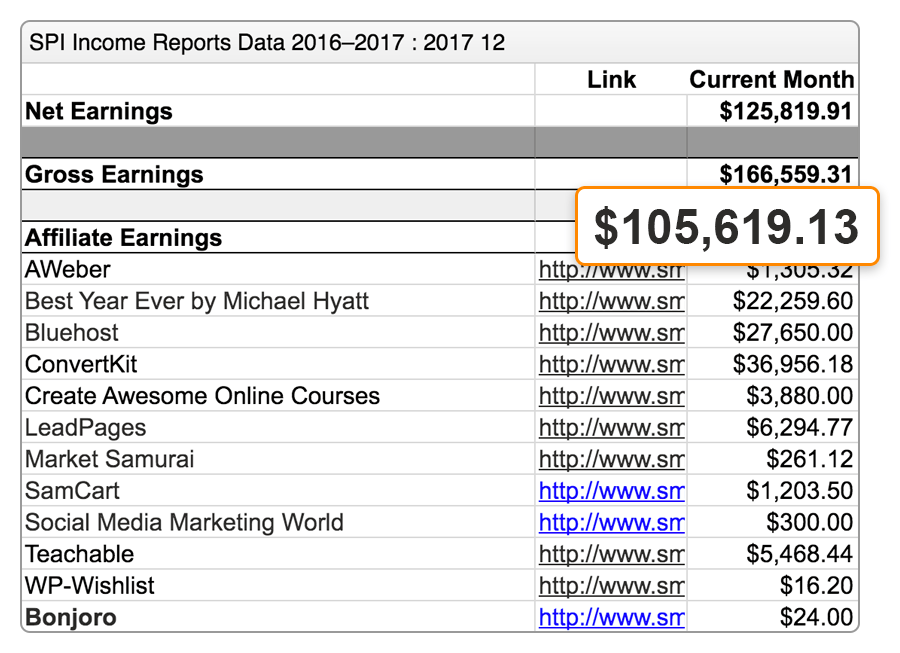
Ryan Robinson, another affiliate marketer, reported over $19,000 in affiliate revenue in October 2019. Another successful affiliate website—The Wirecutter—made an estimated $10 million in revenue, and was eventually sold to the New York Times for $30 million.
Keep in mind though that these people have done an excellent job building their brand. It’s taken them years of hard work to reach this level.
If you’re just starting out, your checks might look more like this for a while:
You need to manage your expectations. You won’t earn the big bucks right off the bat, but don’t let this discourage you.
The success of others tells you that with hard work, time, and the right knowledge, you too can potentially reach those levels.
Choose your niche
Let’s be honest: if you’re starting a blog today, you’re facing a ton of competition. Statista estimates that the number of bloggers in the U.S will reach 31.7 million by 2020.
To stand the best chance of success, niche down.
Choose a topic that focuses on a specific category. For example, the topic of “food” is an enormous category. Rather than tackling that, try something more specific, like grilling food.
Keeping your topics tight can help you build a more focused audience and potentially help you rank higher in search engines.
That’s what I did when I built my first site. Instead of talking about “dance” or “hip hop,” I decided to limit myself to just breakdancing. Despite not knowing anything about SEO back then, I managed to rank for a few key terms and generate ~3,000 organic visits per month.
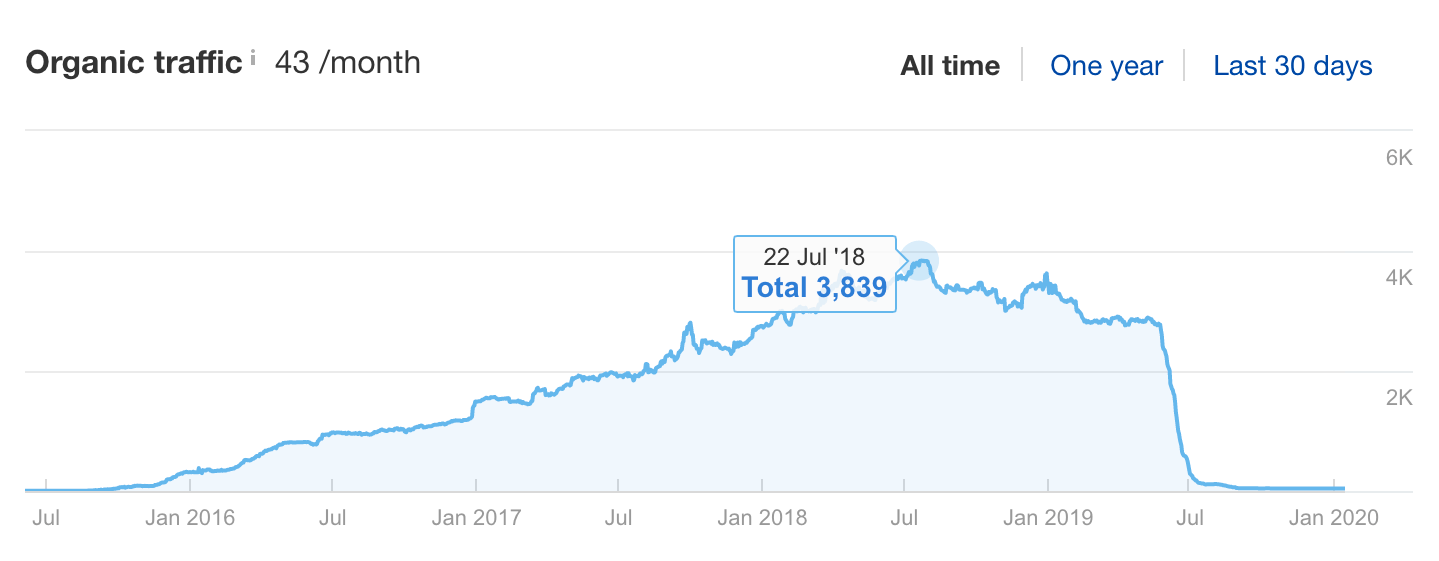
Later on, as you cover the bulk of this category and build traffic to these pages, you can expand into other areas.SIDENOTE. Want some ideas to get started quickly? Here’s a cool list to check out.
Now, if you’re going to be the main content creator, choose something you’re interested in.
Many affiliate sites die due to a lack of consistency. So at the very least, if you’re passionate about a topic, you’ll find it much easier to press on when the going gets tough.
Don’t worry if you’re not an expert in the field. As Gary Vaynerchuk puts it, “document, don’t create.” Documenting what you’ve learned can make great content and attract people who are interested in following your progress.
If you’re outsourcing the content, then it’s better to work with seasoned experts in the niche. Experts can help you create high-quality, trustworthy work, which can lead to more traffic, engaged visitors, and more affiliate sales.
NEXT Step:: Find affiliate programs to join
There are three types of affiliate programs to choose from.
A. High-paying, low-volume affiliate programs
These are affiliate programs for niche products with high payouts.
For example, ConvertKit’s affiliate program pays almost $700 per month if you send just 80 customers their way. However, as they sell CRM software for small business owners, there’s a limited pool of buyers.

There also tends to be more competition for programs with high commissions. Since you’re probably just starting, it’ll be quite challenging to make a meaningful amount of money competing against skilled marketers with deep pockets.
B. Low-paying, high-volume affiliate programs
These are affiliate programs for products with low payouts but mass appeal.
For example, take PS4 games. Lots of people play PS4, but the average cost of a game is only around $50, and affiliate commissions are usually in the single digits. This means you’ll earn $2–3 per sale if you’re lucky.
The redeeming quality of these types of programs is that they usually offer tons of products to sell. Take Amazon’s affiliate program, for example. You can earn up to 10% commissions on almost anything Amazon sells.
The other good thing is that you often get commissions on the entire value of the purchase rather than just the product you recommended.
To make these types of affiliate programs pay, you’ll need lots of traffic.
C. High-paying, high-volume affiliate programs
These are affiliate programs for products with mass appeal, which also pay high commissions.
One example is credit cards.
Everyone needs a credit card, and most people stay with the company for years (sometimes even decades!)
The downside of these types of products is that they attract affiliate marketers with lots of expertise and deep pockets. Some also use spammy tactics that you just can’t compete with.
And since this is a tutorial for beginners, I won’t go any deeper into this.
Just be aware that these programs exist.
How to decide which affiliate programs to join
This depends on your niche and level of expertise.
If you’re targeting consumers, you’ll likely go with the second model of low commissions and higher sales volume.
If you’re going after a business audience, you’ll likely go for the first model: high-paying and low volume. The most popular programs here are for software and web hosting-related products.

The best way to find these affiliate programs is with a Google search.
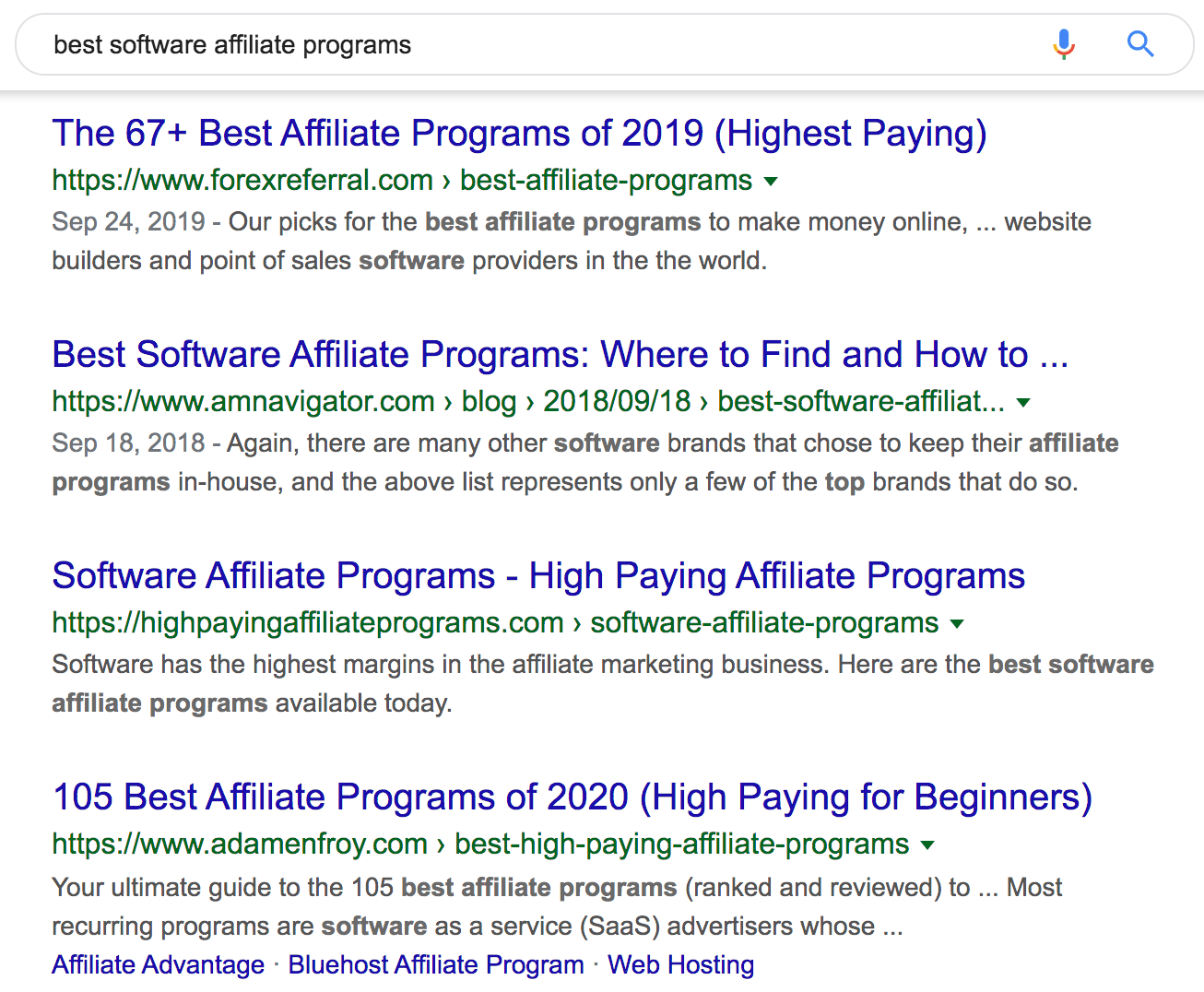
Alternatively, enter a competing affiliate site into Ahrefs’ Site Explorer and go to the Linked domains report.
For example, I know that Pat Flynn promotes several software products on his website, Smart Passive Income. Eyeballing the Linked domains report shows that Pat links to Aweber pretty often.
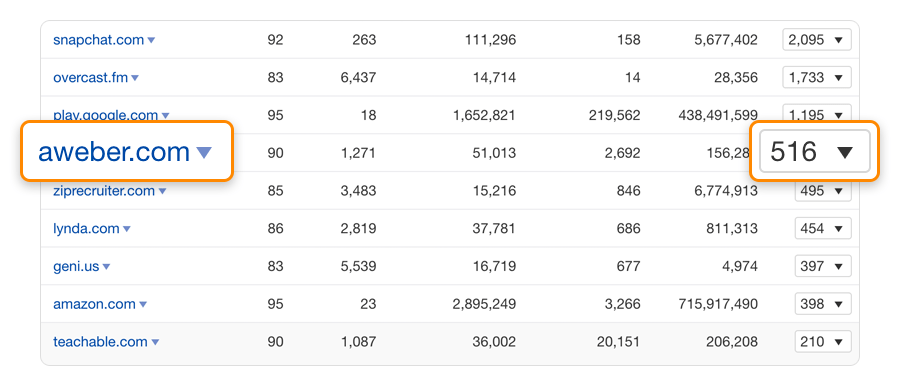
Clicking the “Links from target” caret reveals that Pat is an affiliate.
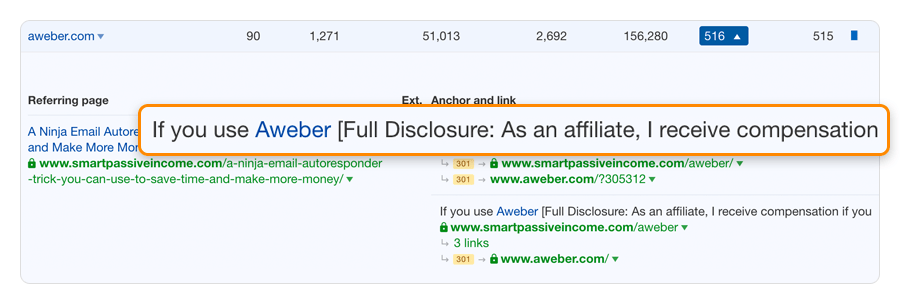
It only takes a quick Google search to find an application form for this program.
However, if there is a product you’d really like to promote without a public affiliate program, reach out to the company and ask if they would be willing to build an affiliate relationship with you.
NEXT Step: Create great content
If you want your affiliate site to succeed, you need to create high-quality content where your affiliate links fit naturally.
Here’s an example. Tim Ferriss interviewed 100+ famous people and asked them this question:
What purchase of $100 or less has most positively impacted your life in the last six months (or in recent memory)?
He published the answers in a blog post and included affiliate links to the products mentioned:

Judging by the comments, his fans loved it.
This is what you have to emulate when creating content for your affiliate site.
Don’t just blindly curate products from Amazon’s best sellers. Go the extra mile to make sure your content solves the visitor’s problem.
How? If you’re doing reviews, actually purchase the product and test it. This is what the Wirecutter did, which explains their success.

If you don’t have money to buy every single product, you can always start with what you have at home. For example, if you had a tech blog, you could create reviews on the gadgets you own.
Final thoughts
No affiliate marketing wheels were reinvented here. These are the fundamentals, and applying them will get you off on the right foot.
Just don’t expect life-changing income or the freedom to quit your 9–5 overnight. Affiliate marketing takes time.
Focus first on making your first affiliate sale. As your site grows, set new goals, and continue experimenting.
This is how to build up a site that eventually generates a decent income.
Got questions? Let me know in the comments or go to the contact us page.
Now, we will look into the areas where Python is heavily used and some of the libraries used.
1. Web Scraping
Sometimes there’s a need to extract data from the internet. This process requires you to access the world wide web(WWW) using either a web browser or a hypertext transfer protocol(HTTP).
To do so python has a range of libraries that access the world wide web and extract data. Scrapy, BeautifulSoup, and newspaper3k are some of the most efficient libraries supported by python.
2. Data Mining
When you extract data from sources you get large amounts of data called raw data. Data mining is the process that helps get data from the raw data.
Only when you extract data from the raw data, you work with it and analyse it. Libraries such as BeautifulSoup, Orange, Scrapy help with this process.
3. Data cleaning
Once you convert the raw data to data you can work with, the cleaning process starts. Almost every time the data is going to contain errors that need fixing. The data cleaning step does cover this.
The data will have missing data, null data, outliers, corrupted data, incorrect data as well as redundant data that needs fixing.
Some of the python libraries that can help here are Beautifier, Datacleaner, PrettyPandas, scrubadub.
4. Data processing and Modelling
Once you have cleaned the data, you can now do analysis and come up with inferences on the data. You can do so by creating visual representations on the part of the data you study or the whole data.
To do so you have to process and model the data. The libraries that help you do so are NumPy, Keras, and Matplotlib.
5. Descriptive and Inferential Statistics
For mathematicians and statisticians, python libraries make life very easy. These libraries have predefined functions for calculating the measures of central tendency or even to identify the skewness or kurtosis of the data.
The libraries that support this are Scipy, Pandas, Scikit-learn.
6. Natural Language Processing
NLP focuses on understanding how we humans communicate with each other, understanding human speech and text. Python over time has come up with libraries to help do that. These libraries include NLTK, Natural Language Toolkit, spaCY, Pattern, PyNLPl
7. Machine Learning and Artificial Intelligence
Machine learning is the process of using the data you have explored to gain insight into it. The machine then uses this knowledge to make educated guesses.
Artificial intelligence, on the other hand, focuses on replicating or trying to get as close to imitating the perception, learning, problem-solving, and decision-making capabilities of the human mind.
Python has various libraries to help people working on these aspects such as MDP, a collection of supervised and unsupervised learning algorithms. Some of the other libraries include mlpy, scikits-learn, Tensor flow, Keras.
8. Graphical Analysis
Many businesses need visualisation to better understand their data. Graphs are one of the most used ones. You can use python libraries such as NetworkX, PyTorch, Matplotlib, Seaborn, and Plotly.
9. Image Processing
Image processing is the process of converting images to digital images and manipulating them. SciKit-Learn is one of the most used libraries.
10. Scientific Computing and Numeric Computing
To perform arithmetic, numeric and scientific computing you use pre-existing functions in python libraries such as SciPy, Pandas, IPython, Numeric Python, NetworkX, scikit-image, h5py, scikit-learn, PyTables.
11. Scripting
When there is a need to help with simple tasks or redundant tasks such as with standard emails or standard responses, python can be helpful. Python allows scripting that is the creation of small programs to automate these simple or redundant tasks.
12. Game Development
Python also has libraries to help with game development such as PyGame, Pyganim. These libraries help with coding and developing games as well as work on the animation required for it.
13. Web Development (Server-side)
Python has libraries that help in the creation and working of the server-side of web development. Some of these include libraries like Django, Flask, Pyramid, and CherryPy.
14. Graphic User Interface
Python also has libraries for developers that work on Graphic user Interface and how to make the interface better and easier to navigate through. They have a wide range of python library options to choose from such as wxWidgets, GTK+, Kivy, Delphi, Qt
Python Architecture and Working
1. Parser
The parser module is the interface between python internal parser and byte-code compiler. The python code uses it to edit the parse tree of an expression and then create the subsequent executable code.
2. Compiler
Python uses the compiler to convert the python code to an intermediate bytecode. The CPython virtual machine can interpret this code.
3. Interpreter
The interpreter reads and interprets the code generated by the compiler which is then executed line by line in the read-evaluate-print-loop method.
Top Companies that use Python
Many of the popular and frequently used applications and websites use python code. Some of the companies that have adopted python for their products are:
1. Facebook
The tech giant that owns Instagram and WhatsApp has been using C, PHP and Python as their top programming languages.
2. Instagram
Instagram, which released in 2010, to be later bought by Facebook in 2012 is one of the most famous and widely used photo-sharing applications. They use python in the backend. Instagram is one of the largest deployments of the Django web framework that is completely written in python.
3. Google
Over time, Python has become one of the most widely used programming languages at Google and recognized as an official language at Google.
4. Netflix
Netflix was first created in 1997 as a movie rental service provider. They allowed users to order movies online and have the DVDs delivered to them. Over time the establishment moved on to the internet. Now they use python as their main language. They use it for everything from operations management and analysis to security and networking.
5. Spotify
Founded in 2006, Spotify is an audio streaming and media services provider. The software uses many different languages but the main language used is Python.
6. Quora
Quora created in 2009 and is a website where internet users add questions and other users answer the questions. The front end of the website uses PHP while most of the other development uses Python.
7. Dropbox
Dropbox is a file hosting service created in 2008. It has about four million lines of Python code. Python is the most used language for its back-end services and desktop app.
8. Reddit
Reddit is a social news aggregation, web content rating, and discussion website created in 2005. The Reddit software uses python for its core.
Python Constructs
1. List in Python
Lists are one of the data-structure in python. They are mutable( changeable) and each element or value that is inside of a list is an item. To create a list you use square brackets as shown below:
Output:
2. Tuple in Python
Tuples are the second type of data structures used in python. They also store many variables in a single variable. Yet, they are immutable and so once defined, it’s impossible to modify. To create a tuple, you use round brackets as shown below:
Output:
3. Dictionary in Python
Dictionaries are the third type of data structures in python. A dictionary consists of key-value pairs and is mutable. You can use keys to access the values or vice versa. You define dictionaries using curly brackets as shown below:
Output:
{1: ‘one’, 2: ‘two’, 3: ‘three’}
Career prospects in python
Over the last few decades, with the rise in consumption and generation of data the demand for python programmers has increased.
As stated in Wikipedia, Python has been part of the top 10 programming languages since 2003 and as of 2021, it’s the 3rd most popular and sought-after language after C and Java.
Some of the major fields using the language are:
- Software Engineer
- Python Developer
- Research Analyst
- Data Analyst
- Data Scientist
- Software Developer
Frequently Asked Questions
Q1. Is python a Programming or scripting language?
Ans 1. Python is a general-purpose programming language. But, Python is capable of scripting as well.
Q2. Why is python an interpreted language?
Ans 2. As the python code is not converted to binary code or machine code before execution. Instead, the compiler creates a bytecode which the python interpreter interprets. And this code is then executed which makes it an interpreted language.
Q3. What is the difference between python modules and python packages?
Ans 3. Python modules are a collection of python classes and python functions. Python packages are a collection of python modules.
Q4. How is memory managed in Python?
Ans: Python’s memory management is in charge of allocating heap space for Python objects. Python also has a garbage collector that recycles all unused memory and makes it available to the heap space.
Q5. Is python an OOP language or a procedural language?
Ans 5. Python is an object-oriented programming language. Yet, also a procedural language as well as a structural language.
Summary
We looked at what is python as a language and why over time it has become a major part of the programming world. We also saw what features help make the language better and more efficient for it to overtake other languages and be more sought after.
Python was conceived in the late 1980s by Guido van Rossum at Centrum Wiskunde & Informatica (CWI) in the Netherlands as a successor to ABC programming language, which was inspired by SETL capable of exception handling and interfacing with the Amoeba operating system.[10] Its implementation began in December 1989.[ Van ossum shouldered sole responsibility for the project, as the lead developer, until 12 July 2018, when he announced his "permanent vacation" from his responsibilities as Python's Benevolent Dictator For Life, a title the Python community bestowed upon him to reflect his long-term commitment as the project's chief decision-maker. He now shares his leadership as a member of a five-person steering council. [43][44][45] In January 2019, active Python core developers elected Brett Cannon, Nick Coghlan, Barry Warsaw, Carol Willing and Van Rossum to a five-member "Steering Council" to lead the project.[46] Guido van Rossum has since then withdrawn his nomination for the 2020 Steering council.[47]
Python 2.0 was released on 16 October 2000 with many major new features, including a cycle-detecting garbage collector and support for Unicode.
Python 3.0 was released on 3 December 2008. It was a major revision of the language that is not completely backward-compatible.[49] Many of its major features were backported to Python 2.6.x and 2.7.x version series. Releases of Python 3 include the 2to3 utility, which automates (at least partially) the translation of Python 2 code to Python 3.
Python 2.7's end-of-life date was initially set at 2015 then postponed to 2020 out of concern that a large body of existing code could not easily be forward-ported to Python 3.[52][53] No more security patches or other improvements will be released for it.[54][55] With Python 2's end-of-life, only Python 3.6.x[56] and later are supported.
Python 3.9.2 and 3.8.8 were expedited[57] as all versions of Python (including 2.7[58]) had security issues, leading to possible remote code execution[59] and web cache poisoning.[60]
EXTRA INFO
FOR COOL DISSCOUNT AT AMAZING STORE LIKE AMAZON,FLIPCART,MYNTRA,SNAPEDEALS,AND MANY MORE GET MEGA DISSCOUNTS ,BIG DEALS AND OFFERS , HOT DEALS AND DISSCOUNT COUPONS ,
SO VISIT OUR WEBSITE TO GET YOUR PIECE OF DISSCOUNTS . COME VISIT DON'T SCROLL DOWN IN A NEXT ONE MORE SECOND COUPON WILL BE SRATCHED AND U WILL BE JUST SCROLL AND SCROLLING.
Download Zip file

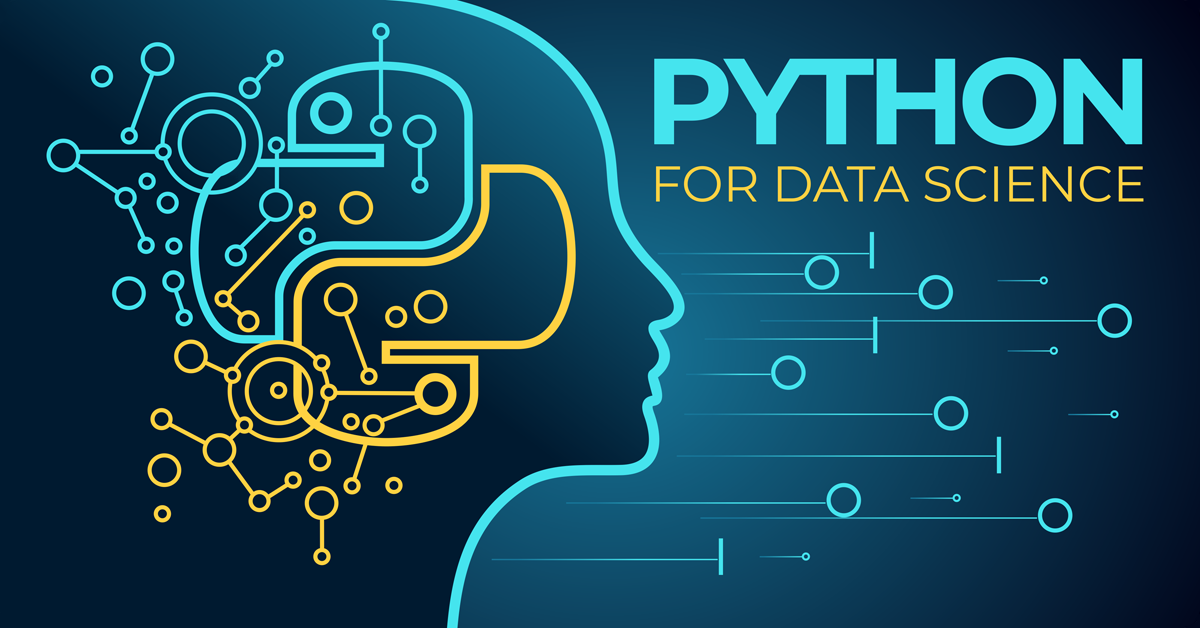
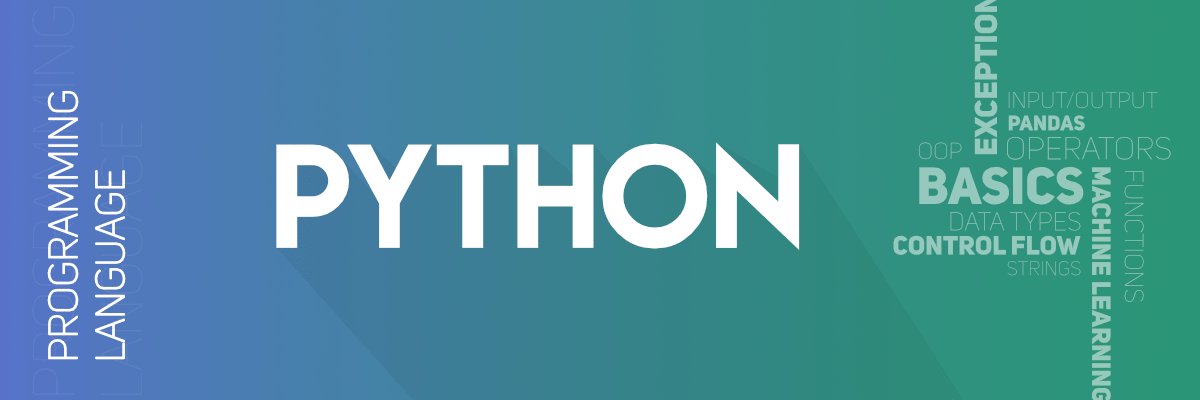




 Trends is an amazing magazine Blogger theme that is easy to customize and change to fit your needs.
Trends is an amazing magazine Blogger theme that is easy to customize and change to fit your needs.